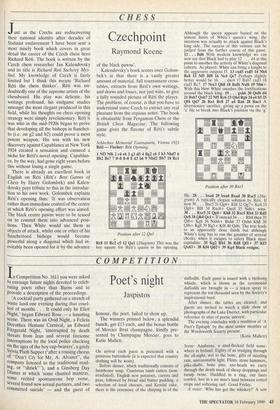CHESS
Czechpoint
Raymond Keene
Just as the Czechs are rediscovering their national identity after decades of Stalinist enslavement I have been sent a most timely book which covers in great detail the career of the Czech chess hero Richard Reti. The book is written by the Czech chess researcher Jan. Kalendovsky and its title is Richard Reti Sachovy Mys- litel. My knowledge of Czech is fairly limited but I think this means 'Richard Rai the chess thinker'. Reti was un- doubtedly one of the supreme artists of the chessboard. His play was delicate, his writings profound, his endgame studies amongst the most elegant produced in this field, while his thoughts on chess opening strategy were simply revolutionary. Red it was who in the mid-1920s began to prove that developing all the bishops in fianchet- to (i.e. on g2 and b2) could prove a most potent weapon. His win with his new discovery against Capablanca at New York 1924 created a sensation and ensured a niche for Reti's novel opening. Capablan- ca, by the way, had gone eight years before this without losing a single game.
There is already an excellent book in English on Rai (Reti's. Best Games of Chess by Harry Golombek) and Kalen- dovsky pays tribute to this in the introduc- tion to his own work. Golombek explains Reti's opening thus: 'It was observation rather than immediate control of the centre at which Reti's opening effort was aimed. The black centre pawns were to be teased on to commit them into advanced posi- tions. Then. White would use them as objects of attack, whilst one or other of his fianchettoed bishops would become powerful along a diagonal which had in- evitably been opened for it by the advance
of the black pawns'.
Kalendovsky's book scores over Golom- bek's in that there is a vastly greater amount of material, full tournament cross- tables, extracts from Reti's own writings, and draws and losses, not just wins, to give a fully rounded picture of Rai the player. The problem, of course, is that you have to understand some Czech to extract any real pleasure from the copious notes. The book is obtainable from Pergamon Chess or the British Chess Magazine. The following game gives the flavour of Reti's subtle style.
Schlechter Memorial Tournament, Vienna 1923 Reti — Fischer: Red Opening.
1 Nf3 Nf6 2 c4 e6 3 g3 d5 4 Bg2 c6 5 b3 Nbd7 6 Bbl Bel 7 0-0 0-0 8 d3 b6 9 Nbd2 Bbl 10 Rcl
Rc8 11 Rc2 c5 12 Qa 1 (Diagram) This was the key square for Reti's queen in his opening.
Position after 12 Qa1 Although the queen appears buried on the utmost limits of White's queen's wing, the intention was actually to attack against Black's king side. The success of this venture can be judged from the further course of this game. 12 . . . Bd6 With modern knowledge we can now say that Black had to play 12 . . . d4 at this point to smother the activity of White's diagonal cohorts. As played, White can bring a knight to the aggressive outpost f5. 13 cxd5 exd5 14 Nh4 Re8 15 Nf5 Bf8 16 Nc4 Qc7 Perhaps slightly better would be 16 . . . dxc4 17 Bxb7 cxd3 18 exd3 Rc7. 17 Nce3 Qb8 18 Bxf6 Nxf6 19 Nh6+ With this blow White smashes the fortifications around the black king. 19 . . . gxh6 20 Qxf6 d4 21 Bxb7 Qxb7 22 Nf5 Rc6 23 Qh4 Rg6 24 e4 b5 25 Qf4 Qd7 26 Ral Rc8 27 a4 Ra6 28 Racl A diversionary sacrifice, giving up a pawn on the 'a' file to break into Black's position via the 'g' Position after 30 Rxc5
•
file. 28 . . . bxa4 29 bxa4 Rxa4 30 Rxc5 (Dia- gram) A typically elegant solution by Reti. If now 30 . . BxcS 31 0g4+ Kf8 32 0g7+ Ke8 33 Qg8+ Bf8 34 Rxc8+ Qxc8 35 Nd6+ wins. 30 . . . Rxc5 31 Qg4+ Kh8 32 Rxc5 Rb4 33 Rd5 Qc8 34 Qh4 Qel + If instead 34 . . . Rbii then 35 016+ Kg8 36 Nxh6+ Bxh6 37 Oxh6 Kh8 38 Qf6+ Kg8 39 Rg5+ Kf8 4() 0d6. The text leads to an apparently close finish but although White's king has to run the gauntlet of several checks, when it escapes to safety Black must capitulate. 35 Kg2 Rbl 36 Rd8 Qfl+ 37 K13 Qxd3+ 38 Kf4 Qd2+ 39 Kg4 Black resigns.


















































 Previous page
Previous page